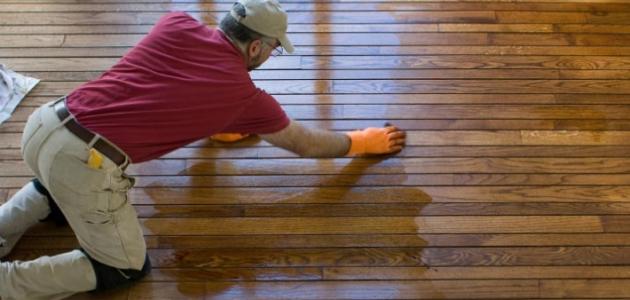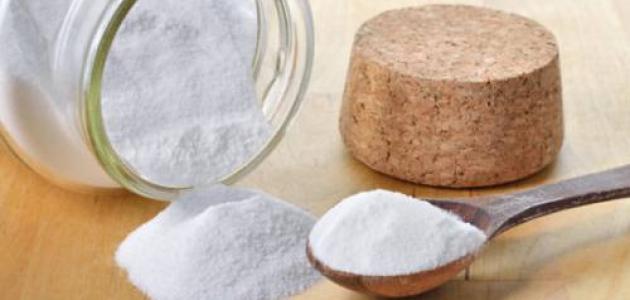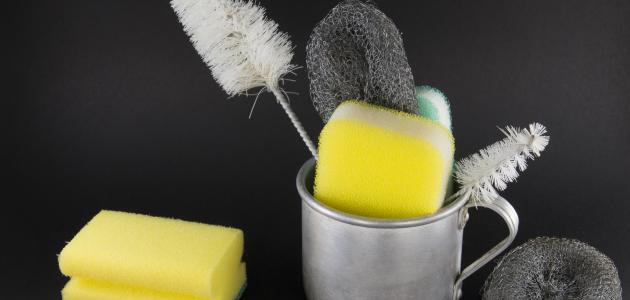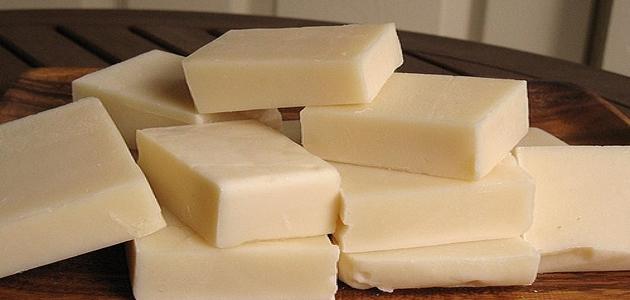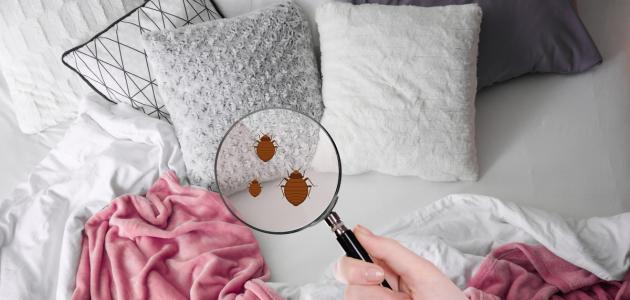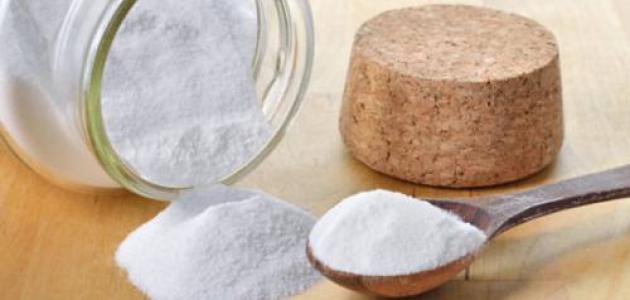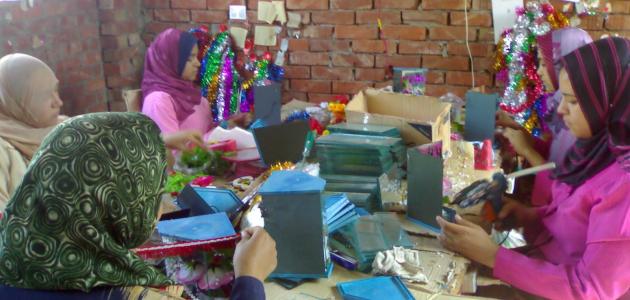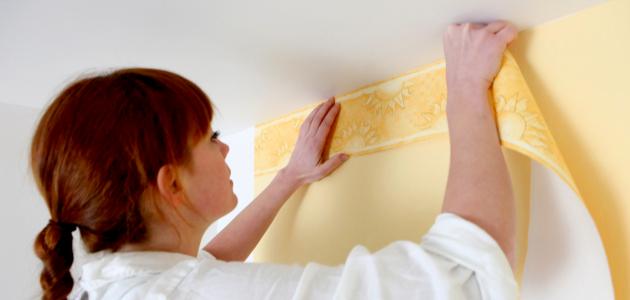Parquet polishing method
It should be noted that the parquet floors should be cleaned on a regular basis every week, then polished with the materials designated for that approximately every two to four months; to preserve and protect it from scratches and damage, and care must be taken when using water during cleaning; As it causes damage to the parquet that is not coated with an insulating layer, as it is possible to know whether the parquet is coated or not by experimenting with placing a small drop of water on the floor and waiting for a few hours. Water should be used while cleaning them.
using commercial products
The floors are polished after they have been cleaned by following the following steps:
- Buying the right type of polish for floors; Where the polish that contains water (in English: water-based polish) can be used to polish the polyurethane floors, while the other floors must choose wax-based polish to polish them, and it is recommended to choose products that are free of volatile organic compounds.
- Follow the instructions for use and safety instructions included with the product.
- Test the material on a small, hidden area before polishing the entire floor; Where the material can be placed on the specified area, and wiped using a soft cloth, and if the color of the floor changes, this indicates that the product is not suitable for this type of floor.
- Spray an appropriate amount of the solution on the cloth, or spray it directly on the floor and wipe it with the cloth according to the instructions written on the product packaging. It is preferable to wipe the floor in a semi-circular and wavy motion to avoid traces of streaks appearing on it.
- Start wiping from inside the room to the outside in order to prevent the scanned area from getting dirty again. Where it is possible to start from one of the corners of the inner room and move gradually and tangentially to the next corner, and drag the mop along the room towards the third corner, followed by the last corner, then polish the middle of the room, and finish polishing the area near the entrance to the room, and if the floor is waxed, then this is repeated Steps from two to three times at a rate of once a day.
- Wait until the floor is completely dry; As you must wait for a period of 24 hours before walking on it, and you must wait for two days before returning the furniture to the room.
using a homemade solution
Parquet floors can be polished using a home solution by following these steps:
Read also:Why spiders are in the house- Sweep the floor with a hand broom and dustpan.
- Sweep the floor using the vacuum cleaner to make sure it is free of any impurities.
- Prepare the solution by mixing a cup of white vinegar with one or two tablespoons of olive oil, and put them in a sprinkler and fill it with distilled water.
- Start polishing by spraying an appropriate amount of the solution on the floor and wiping it with a sponge mop, taking into account starting from the inside of the room towards the outside and parallel to the fibers and wood grains.
- Gently pat the floor with a piece of synthetic fiber cloth until it is completely dry.
Parquet cleaning methods
Homemade solutions are a good option for cleaning wooden floors, but before starting cleaning and using water, you must know the surface layer of the floor and whether it is coated with a waxy substance or not. Where the use of water on the floor coated with a waxy material causes damage to it, and it is also possible to contact the flooring manufacturer in the event of any inquiries about cleaning the floor.
Periodic cleaning
To keep parquet floors clean and shiny constantly, they must be cleaned regularly, by following these steps:
- Wipe up any spilled material directly on the floor.
- Sweep the floor frequently to avoid the accumulation of impurities, dust, and gravel that may scratch the floors.
- Use a slightly damp mop to wipe the floors only four times a year, in the event that the continuous cleaning of the floors is not neglected or soiled with mud or any sticky substance.
- Light patting with a dry cloth after wiping to prevent streaks.
- Use a small amount of commercial cleaner, not more than half a teaspoon per 0.18 m2 of parquet, and only in emergency cases.
Clean with a commercial cleaner
Parquet floors are cleaned using commercial detergents by following these steps:
Read also:Removing rust from iron- Sweep the floor with a broom.
- Choosing the right cleaning product; It is preferable to choose a cleaner dedicated to wooden surfaces that contains sealants and materials that keep them shiny and durable for as long as possible, and it is not recommended to use wax products during cleaning.
- The possibility of preparing a cleaning solution at home; By mixing a bucket of warm water with a quarter cup of dishwashing liquid, and it should be noted that it is necessary to avoid using materials containing ammonia, oily soap, or any materials with a high pH.
- Wipe the floors with a wet mop, and be careful not to overuse water, as the mop is placed in water and dried as much as possible so that it is slightly damp, and if a commercial solution is used, you must read the instructions to know the appropriate amount of water that should be added to it.
Cleaning with natural materials
Parquet floors often do not need much maintenance, but routine wiping is sufficient, and if the floor is very dirty and needs deep cleaning, household cleaners can be used that save time, effort and money when used, and among these materials are the following:
- Water and vinegar: Using warm water and vinegar is an easy solution to cleaning parquet floors from dirt and germs.
- Water, vinegar and essential oils: A few drops of one of the preferred essential oils can be added to the water and vinegar solution to add a pleasant scent to the floors.
- Vinegar and vegetable oil: You can replace the water in the vinegar solution with vegetable oil and put it in a sprinkler to clean floors that are not allowed to use water to clean.
- Vinegar, water and vegetable liquid soap: This mixture is a good option for very dirty floors, as both vinegar and soap made from vegetable oils are mixed with water, with the possibility of adding essential oils if desired.
- Lemon juice, olive oil and hot water: They are mixed together and used to clean and brighten floors.
- Dishwashing liquid, water and vinegar: These ingredients can be mixed together and a synthetic fiber cloth or sponge can be used to clean.
Cleaning and polishing of oil-coated parquet
The mechanism for dealing with oily floors differs from those made of polyurethane, and the following steps can be followed to clean and polish oily floors:
Read also:Electronic hookah damage- Sweep the floor to get rid of dust and dirt.
- Use cleaners for oily wooden floors available in the market, and in the event that there are any stubborn stains, the detergent can be left on for ten minutes before wiping it off.
- Wipe the floor with a soft cloth.
- Wipe the floor with a clean cloth and a small amount of oils for wooden floors, and leave it to dry for two hours before walking on it or placing furniture on top of it.
- Getting rid of pieces of cloth that contain oil; it is considered dangerous and flammable, and if it is not disposed of, it must be cleaned by soaking it with water and then stored in a tightly closed metal container.
Cleaning and polishing waxed parquet
Waxed floors need special care, as they are sensitive to the use of water on them. Among the most important tips for cleaning and polishing these floors are the following:
- Daily cleaning of the floor by sweeping or slightly damp mopping, as the amount of water used should be reduced as much as possible and the floor should be kept dry.
- Use a small amount of water without adding any type of detergent, whether it is soap, ammonia, or other chemical cleaners.
- Polish the floor with a lint-free cloth.
- Replacing the waxy layer with a new one once or twice a year, and the old layer can be disposed of by rubbing the floor with a special wax remover, or odorless mineral spirits, or using quick-drying naphtha (in English: Naphtha), then Wipe the floor with a clean cloth, wait until it dries completely, then apply a thin layer of wax using another clean cloth and leave it to dry, then put another layer in the same way, and after the layers dry, the floor is polished with another clean cloth parallel to the direction of the wood grains. by disposing of all used cloths or by washing them with water and keeping them in a tightly closed metal container; due to its flammability.
Distinguish the final layer of parquet
There are different types of parquet surfaces; Some of them contain polyurethane, and others contain other materials that are tougher and easier to clean, but it is more difficult when thinking about adding another reinforcing layer to it because it is difficult to stick to it. Here are some tips and information to distinguish the surface layer and know its type.
Different types of final layer
There are several options and many types to be used as a surface coating; Such as wax floors, varnishes, penetrating oils, shellacs, and polyurethanes, which are water-based or oil-based varnishes that give a glossy appearance, and a catalyst may be attached to it. Some types of polyurethane to increase surface hardness when mixed together, and floors coated with a layer of aluminum oxide (in English: aluminum oxide) are among the toughest layers and most resistant to adhesion to any other layer.
Distinguish between waxy and oily layers
The floor that contains penetrating oils can be distinguished by passing the hand over the surface, where it will be noticed that there are slightly prominent granules in this type of floor, and the presence of wax can also be distinguished by using a piece of metal, rubbing it with a small part of the surface, and noting the presence of traces of wax on The metal piece, and a piece of cloth soaked in mineral alcohol can be used and rubbed part of the surface with it. If you notice a change in the color of the piece of cloth, this indicates the presence of wax.
Distinguish between shellac and polyurethane coatings
The scratching method with a blade is used to distinguish between lacquer and polyurethane; Where a small hidden part of the floor is scratched with a blade, and a drop of alcohol is placed on the traces of the material that was scraped off, then pressed on it with a piece of glass. Varnish, polyurethane or aluminum oxide.
Marking of aluminum oxide surfaces
The final layers made of aluminum oxide are considered one of the hardest and thickest types of layers, and this is due to their application in factories, and they are guaranteed by the manufacturer for a period of twenty years, so they are the most durable types, and if any signs of damage or damage appear on the layer, this indicates It is not aluminum oxide, and it should be noted that specialized products must be used if you want to renew the aluminum oxide layer.
Reasons for fading parquet
Among the most important reasons that lead to fading of parquet floors are the following:
- Neglecting sweeping and wiping in the wrong way: Neglecting to sweep and remove dust and dirt, or using a dirty mop, leads to distributing and spreading dirt on the floor and leaving it stuck to the surface.
- Choosing the wrong floor cleaner: Acrylic-based liquid waxes are not suitable for cleaning floors that contain polyurethane or wax. As the floor appears as if it is stained and not shiny, so drops of a mineral solution can be used to get rid of the stained appearance, restore the luster of the floors, and remove the inappropriate cleaner from the floor, as chlorine, ammonia, concentrated vinegar, and pine oil are considered (in English: pine oil), materials that are not suitable and harmful to floors, so it is advised to read the attached instructions to choose the appropriate product and follow the advice of experts.
- Excessive use of water or cleaning agents: Excessive amounts of cleaning product or water will dull the floors.
- Incorrect cleaning and polishing: All cleaning and polishing steps must be completed correctly and carefully. A dry mop must be used to finally polish the floor after wiping or waxing it.
- Floor scratches: Pets cause scratches on the surfaces due to their nails or claws, and scratches can also occur due to sharp tools in the house, which leads to fading of the surfaces.
- Use of carnauba wax on top of the polyurethane layer: The application of carnauba paste wax on top of polyurethane surfaces leads to fading of the floors due to the accumulation of wax, even if it is used once or twice a year, and this wax can be removed using a mineral solution or a special commercial product for that.
- Neglecting to restore finished surfaces: All surfaces are exposed to wear and tear, whether they are rough or not, so they must be refinished and restored from time to time.
Steps to maintain parquet
Among the most important tips for maintaining parquet floors are the following:
- Avoid false information and advice on various websites. It is recommended to contact the manufacturer and consult them about cleaning methods and appropriate materials.
- Choosing the appropriate cleaning product, as the use of an inappropriate product leads to severe damage to the floors; Such as wear, discoloration of the floor, cracking, or the appearance of floors with a smudged and wavy appearance.
- Avoid using a hard-bristled brush while cleaning the floor to prevent scratches.
- Avoid excessive use of water when mopping floors. It is impossible to treat the damage caused by water seeping into the floors, so they must be kept dry.
- Refrain from using a steam mop on parquet floors. As the heat generated by the use of this mop pushes moisture into the floors, and thus the occurrence of contractions, bulges, or dents in the layers, as well as cracking and crumbling over time.
- constant trimming of the nails of pets in the home; This is to avoid causing scratches.
- Covering the most used areas by placing carpets on them, and it is preferable to place carpets at the entrances and exits of the room to reduce dirt.
- Clear the room of furniture before cleaning it, and this must be done carefully to avoid scratching the floors during transportation.
- Immediately clean the floor if it gets dirty with stains, and a slightly damp cloth can be used to do so.
parquet
The word parquet refers to some types of wooden floors, and its name goes back to the French word (parqueterie), and this type of flooring began to be manufactured in the middle and late seventeenth century, and it is solid wood planks that are made by assembling small pieces of wood over a grid It is made of paper, cloth, or plastic, fixed by metal or plastic wires, and the wooden pieces are joined together through certain adhesives, and these wooden pieces may be oak, maple, walnut, or other hard wood species.
Parquet boards are made in several sizes; Such as: 22.86 cm * 22.86 cm, or 30.48 cm * 30.48 cm, or 48.26 cm * 48.26 cm, and their thickness ranges between 0.8 cm and 1.9 cm, and these panels are attached together on the ground, to form consistent geometric shapes in the form of squares, or Triangles, or lozenges, then these shapes are arranged either in a classic way in the form of unified bands, or in the form of a tapestry of overlapping and complex shapes.
